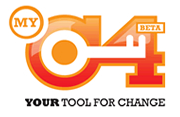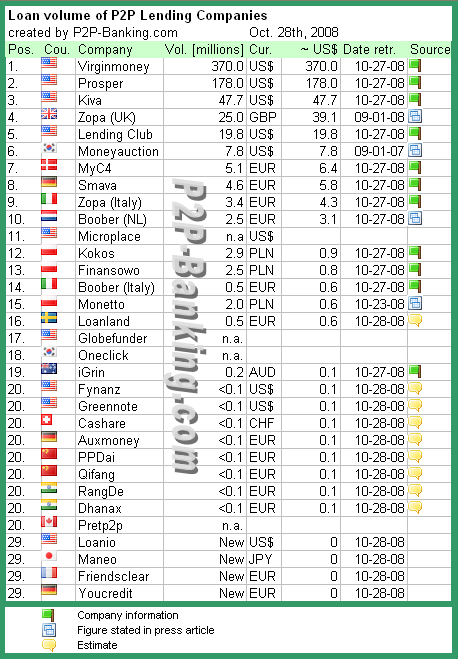Found this today. Someone using Lending Club‘s new Note Trading Platform seems to speculate that a bulk buyer of notes might overlook the added zero in the value?

Retrieved Nov. 3rd, 2008 – some columns have been removed to allow better overview.
Found this today. Someone using Lending Club‘s new Note Trading Platform seems to speculate that a bulk buyer of notes might overlook the added zero in the value?

Retrieved Nov. 3rd, 2008 – some columns have been removed to allow better overview.
![]() One of the downsides of p2p lending service Prosper.com are high default rates. Results from collection attempts are low.
One of the downsides of p2p lending service Prosper.com are high default rates. Results from collection attempts are low.
In an attempt to test alternatives to the existing collection process Prosper in January selected 66 cases of nonpaying borrowers and turned them over to the law firm Hunt & Henriques to pursue these cases in court.
Fred 93, one of the lenders on these loans researched the status of the court cases himself, dissatisfied that Prosper did not inform him on the status, which he says Prosper initially promised to do monthly.
According to Fred93’s findings, Prosper.com so far lost 6 cases and won 1 case.
 The Industrialisation Fund for Developing Countries (IFU) and CSR Capital have decided to invest a total of DKK 15 million (approx. EUR 2.2 million) in Africa through MYC4. The Danish Development Minister Ulla Tørnæs supports the decision.
The Industrialisation Fund for Developing Countries (IFU) and CSR Capital have decided to invest a total of DKK 15 million (approx. EUR 2.2 million) in Africa through MYC4. The Danish Development Minister Ulla Tørnæs supports the decision.
“This is an extremely important milestone for MYC4. That IFU and CSR Capital now invest through MYC4 is an endorsement of our initiative as a serious tool in the fight to eradicate poverty in Africa through the marketplace myc4.com,” says CEO of MYC4 Mads Kjær and continues:
“We hope this will inspire financial institutions, pension funds and companies to invest in Africa through MYC4. We are already well under way, but to make a significant difference for the development in Africa, this kind of investors play an important role.â€
Political support
Danish Development Minister Ulla Tørnæs warmly welcomes IFU’s initiative to invest in Africa through MYC4.
“Danida has been the facilitator for MYC4. Through the Public Private Partnerships, Danida has supported the development of MYC4. I am glad to see the interest and support for the new marketplace. It shows the economic potential for investments in Africa,” says Tørnæs.
DKK 10 million from IFU, 5 from CSR Capital
IFU is an independent fund under the Danish Foreign Ministry. IFU’s purpose is to promote economic development in developing countries in partnership with the Danish industry, and now the fund invests DKK ten million in Africa through MYC4.
“With the investment IFU wants to contribute to poverty reduction and business development of small and medium enterprises in Africa,” says Investment Manager Kasper Svarrer from IFU.
In addition, the private investment firm CSR Capital invests DKK five million through MYC4. CSR Capital focuses specifically on social and environmentally sustainable investments:
“Good investments and development can and must go hand in hand in order to create the basis for sustainable economic, environmental and social growth and welfare in any society”, says CEO of CSR Capital Sven Riskær.
(Source: MyC4.com)
 Loanland launched last December as the first p2p lending company in the swedish market (see ‘Loanland launches peer to peer lending in Sweden‘). Since then about 5.7 million SEK (approx. 0.75 million US$) loan volume has been funded .
Loanland launched last December as the first p2p lending company in the swedish market (see ‘Loanland launches peer to peer lending in Sweden‘). Since then about 5.7 million SEK (approx. 0.75 million US$) loan volume has been funded .
Ville Vesterinen has published more information about Loanland in the ArcticStartup blog:
The company is currently providing unsecured loans to the Swedish market. The Swedish market for unsecured loans to households amount to around 160 billion SEK (around 16 billion EUR or 20 billion USD) at present and with unsecured loans to SMEs the figure is about 500 billion SEK (around 50 billion EUR or 63 billion USD). The market has grown 15% annually during the last few years.
…
Loanland is using an open source platform that it has developed, automating most of the processes. The technology is based on Java, J2EE, MySQL, Tomcat, Spring and Hibernate. The platform and auction engine allows individual and automatic bidding, electronic signatures, integrated credit scoring and efficient payments.The company … has already over 10 000 members and 5 000 registered borrowers and lenders. They have 6 million SEK (600K EUR or 750K USD) deposited out of which 95 percent is lend out as loans. Quite significant number considering that the startup operates currently only in Sweden.
ABC interviewed Renauld Laplanche of Lending Club on ABC Money Matters. Laplanche says in the last 10 days over 1 million US$ in loans were funded and states that the default rate has been lower than 2% over the last 18 months. Watch the video.
P2P lending is spreading internationally. While the biggest loan volumes are generated in the US market, many p2p lending websites have been established in other international markets.
The services can be divided in three categories:
Sites funding student loans can fall into any of these three categories or combine motivations.
P2P-Banking.com has created the following overview table listing services that are in operation and ranked them by loan volume. The loan volumes are not directly comparable for they are cumulative since launch of each service and represent different time spans.
Asked for a figure, a Microplace spokesman pointed out “…it is important to note that MicroPlace is not a P2P site. We are a platform that offers investments to the retail public.“. No loan volume was quoted, but he stated “investments purchased on our site have enabled over 26,000 microfinance loans.”
In total approx. 685 million US$ have been funded through peer to peer lending/social lending services so far worldwide.

This image may be reprinted on other internet sites, provided it is not altered or resized and the following text (including the direct link to this article) is given as source directly below the image:
Source: P2P-banking.com
If you are a representative of a p2p lending service and want your service to be included in the next update of this table, please send me an email with information about your company.